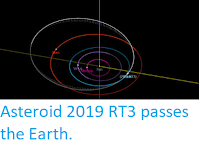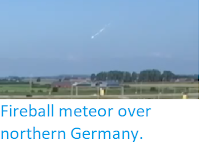Asteroid (504800) 2010 CO1 passed by the Earth at a distance of about 5 327 000
km (13.9 times the average distance between the Earth and the Moon, or 3.56% of the distance between the Earth and the Sun), slightly after 3.40 am
GMT on Saturday 14 September 2019. There was no danger of
the asteroid hitting us, though were it to do so it would have
presented a significant threat. (504800) 2010 CO1 has an estimated
equivalent
diameter of 82-260 m (i.e. it is estimated that a spherical object
with
the same volume would be 82-260 m in diameter), and an object at the upper end of this range would be predicted to be capable of
passing through the Earth's
atmosphere relatively intact, impacting the ground directly with an
explosion that would be about 60 000 times as
powerful
as the
Hiroshima
bomb. Such an impact would result in an impact crater about 4
km
in
diameter
and devastation on a global scale, as well as climatic effects that
would last decades or even centuries.
The calculated orbit of (504800) 2010 CO1. JPL Small Body Database.
(504800) 2010 CO1 was discovered on 31 January 2010 by the NEOWISE system on the Wide-field Infrared Survey Explorer
satellite. The designation (504800) 2010 CO1 implies that it was the 38th
asteroid (asteroid O1 -
in numbering asteroids the letters A-Y, excluding I, are assigned
numbers from 1 to 24, with a number added to the end each time the
alphabet is ended, so that A = 1, A1 = 25, A2 = 49, etc., which means that O1 = 14 + (24 X 1) = 38) discovered in the sixth and seventh weeks of 2010
(period 2010 C), while
the designation 504800 implies that it was 5048 00th asteroid ever
discovered (asteroids are not given this longer designation immediately
to avoid naming double or false sightings).
(504800) 2010 CO1 has a 372 day orbital period and an eccentric orbit
tilted at an angle of 24.0° to the plane of the Solar System, which
takes it from 0.79 AU from the Sun (i.e. 79% of he average distance at
which the Earth orbits the Sun) to 1.23 AU from the Sun (i.e. 123% of
the
average distance at which the Earth orbits the Sun). It is therefore
classed as an
Apollo Group Asteroid (an asteroid that is on average further from the
Sun than the Earth, but which does get closer). This means that close
encounters between the asteroid and Earth are common, with the
last having occurred in September 2018 and the next predicted
in September 2020. As an asteroid probably larger than 150 m in diameter
that occasionally comes within 0.05 AU of the Earth, (504800) 2010 CO1 is also
classified as a Potentially Hazardous Asteroid.
See also...
Follow Sciency Thoughts on Facebook.







